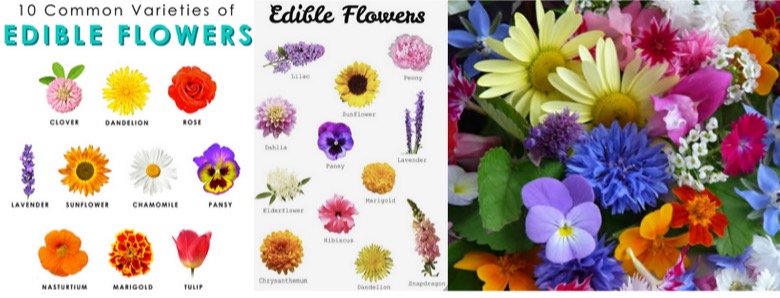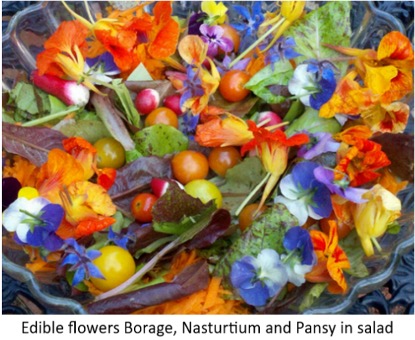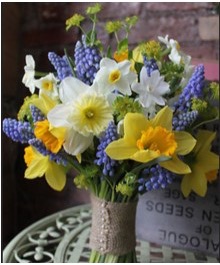Growing and Using Edible Flowers by Sharon Smith
Why is it useful to know which blooms are edible? Well, because it adds another way to enjoy your garden and a certain relationship forms when blossoms are consumed. I like to think it adds greater awareness of the plants in our yards, another dimension of their value perhaps.

This article is an introduction to common flowers that are safe to eat with information about how to grow and use them. Flowers have formed part of some cuisines for a long time such as Asian, Middle Eastern and European. I have also been using edible flowers from my yard, many commonly in salads and others in cooking. Variations of colour, taste and shape of blooms in salads adds so much appeal, not to mention they are so easy to add by just going outside to pick them when ready to assemble. Some have subtle and others more pronounced flavours. Plus some are perennial and other annuals that you can change yearly for diversity.
Edible flowers exist in many common plants and in beautiful colours and forms. Sometimes there is not much effort required to find edible flowers as they often grow in full sight but you need to know which ones they are. Importantly, this article is not an endorsement to eat any flower as some can be toxic or present a serious risk of illness. For example, flowers you must never eat include Monkshood, Lily of the Valley, Hyacinth, Foxglove, Iris, Anemone, Sweet Pea, Lupin, Buttercup, Delphinium, Morning Glory and Azaleas, among others. It is therefore immensely important that you have correctly identified your edible blossoms.
So where to start with edible flowers you may say? Well, perhaps a simple way to describe a selection of edible flowers is by how they can be used. This includes flowers for 1) Decorative (and edible) use in salads or desserts; 2) Infusions for flavouring vinegar, honey, oil and water; 3) Baking; and 4) Cooking. When collecting flowers to eat it is important that they have not been sprayed with any chemicals. In your own gardens you can have more assurance that the target plants are grown organically but difficult to know if harvesting them from around your neighbourhood. In the following descriptions of some selected, common blooms you will see what they are and how to grow and use them.
Here are some preparatory notes for edible blooms. Edible flowers keep poorly even when refrigerated so don’t cut them until the last minute and use them as quickly as possible. Snip the flowers and, if needed, soak them briefly in lightly salted water to remove any hidden insects or dirt. Let them drain and dry thoroughly on towels. For recipes requiring only petals snip off the bases and scatter the petals onto a towel, drying only to remove surface moisture. Some flowers can also be dried and used in baking or for floral confetti.

1) Decorative Flowers in salads, desserts or other: Decorative and edible flowers for classic garden salads include, for example, Nasturtium, Violet/Pansy, Calendula, Borage, Snapdragon, Evening primrose, Impatiens, herb flowers (e.g. chives, basil, mustard) and tuberous begonias.
For sweet fruit salads or desserts you can sprinkle on top flowers such as Sweet Cicely, Forget-me-not, Climbing Honeysuckle, Phlox (all references mean tall garden phlox: Phlox paniculata), Lemon Verbena, Pinks, Violets, Pansies and Bergamot.
Nasturtiums: These annuals come in a large assortment of bloom colours and growth habits until fall frost. You can grow them in planters or in your garden but be aware that they should not be in rich soil or they may produce largely leaves. Average soils are best. You can direct sow the seeds once risk of frost has passed. All parts of this plant are edible – flowers, leaves and fresh seeds that are pickled can replace capers. Nasturtiums taste strong, tangy and peppery and the flowers are large and particularly showy in salads.
Pansies and Violets: Pansies and violets are simple to grow in part shade where they have moist soil. They produce such lovely flowers in different colours, sizes and patterns which are used whole as colourful additions to salads, decorations for desserts, in jellies and syrups. Play with colour combinations with other flowers or petals like Calendula and Borage.
Borage: Bright blue flowers show from mid-summer onwards. These annual plants need full sun and can grow in poorer soils. Pick the flowers off the stems. All parts of the flower are edible and taste a bit like cucumber. Their blue colour is stunning, particularly with orange Calendula or Zinnia petals or Nasturtiums in a mixed salad or in ice cubes for summer drinks.
Calendula: Also known as Pot Marigolds these annuals are super easy to grow and bloom best in average soils. Just sow in a sunny spot or planter allowing for their sprawling size (1.5 ft tall) and abundant blooms. The flowers are commonly either yellow or orange and the petals make lovely colourful accents in salads. I love their orange petals in tandem with blue Borage flowers. You can cook with the petals too, as they are also called ‘Poor man’s saffron’, for use in risottos. You will need to pull the petals off as the stalk and flower centre are not edible. Tulips: Large, smooth tulip petals have a sweet lettuce or cucumber flavour but with a slight peppery aftertaste. They can be used as little platters for canapés, or on their own in spring salads. Just cut off the stem at the base and then the flower head. Gently pull off the petals, removing any pollen or anthers.
2) Flowers for Infusions: Keep in mind that infusions can involve different liquids including vinegar, oil, honey and water. Water mixed with sugar will produce sweet syrups. Scented flowers include Roses, Jasmine, Lilac, Bergamot, Forsythia, Climbing honeysuckle, Phlox, Dianthus, Lovage and Evening Primrose.

To make a floral vinegar you will need about 500 ml of white wine vinegar and a handful of freshly picked scented edible flowers. Gently warm the vinegar over low heat. Add the flowers to a sterile glass jar or bottle. Pour the warm vinegar over the flowers and seal immediately. Leave for a week to infuse and then strain into another sterilized bottle. Use in dressings and marinades and the vinegar will last up to six months.
To make floral oil stand several flowers in 500 ml of light vegetable oil, such as canola, in a small, sterilized jar. For chive blossoms you can also include the stems. Avoid nut or olive oils as they impart their own characteristic flavour. Seal the jar and let sit for a week to allow infusion of the flavour. Infused oils will last up to six months.
Purchased runny honey is used to make flower-flavoured honey with home grown blooms. Place a layer of freshly picked scented petals in the bottom of a small, sterilized jar. Pour a small amount of honey to cover them and then put in another layer of petals. Repeat until the jar is filled and seal with the lid. This will keep for 6 months. Good flowers to infuse in honey include Climbing Honeysuckle, Lilac, Violets, Forsythia, Roses and Dianthus.

Floral cordials use a handful of freshly picked scented petals or flowers including Climbing Honeysuckle, Lilac, Hibiscus, Rose or Jasmine. Put the petals in a large bowl with 4 ½ cups granulated sugar, one sliced lemon and 2 litres of still mineral water. Cover with a clean cloth and leave to infuse for 24 hours, stirring occasionally. Strain the liquid through a sieve and decant into sterilized glass bottles. Seal and refrigerate. Use within 2 weeks.
You can also use any scented edible flowers to make flavoured waters that can be used in sweet or savoury batters, dressings and marinades or mixed with icing sugar to drizzle over fruit salads. Add a handful of clean edible petals or flowers to a saucepan. Just cover them with mineral water. Place the pan on low heat and cover with a lid. Simmer 30-45 minutes until the petals or flowers lose their colour. Do not boil. Strain and pour into sterilized glass bottles or jars and store in the refrigerator.
A fun way to keep some scented blooms is frozen in ice cubes that are added to summer drinks. Some suitable blooms include Forget-me-nots, Phlox, Impatiens, Evening primrose, Chicory, Borage and Pansies. In addition, they make delicious jams, jellies, ice cream and floral sugars. More savoury-flavoured blooms are good mixed into butter.
Last but not least scented blooms are good for tisanes. Just pour boiled water over a small handful of fresh flowers or petals (enough for one or two drinks) and steep. Strain before serving. Popular tisane flowers include Chamomile, Jasmine, Lemon Verbena, Rose, Sweet Cicely, Common Valerian, Catmint and Rose of Sharon.
Chives: Chives and other onion flowers can be used in two ways. First when you pull the flower clusters apart just sprinkle them on dishes where you would like a bit of an oniony accent including salads, fish dishes, omelettes, pastas etc. Secondly, and more popular is infusing oil or vinegar with chive flowers which also changes the liquid to a pinkish colour. Just fill a sterilized jar with chive flowers including stems, cover with oil or vinegar, seal and let sit for at least a week. Such oils and vinegars are good additions to homemade vinaigrettes.

Jasmine: Usually jasmine (Gardenia jasminoides) is grown as a houseplant that can go outdoors in the summer in a sheltered position with dappled light. The white floral rosettes are waxy with intoxicating perfume, sweet and almond-like flavour. Pick the flowers as they appear for use in tisanes, honey, cordial, jams or jellies and a few blooms go a long way.
Forsythia: Masses of yellow blossoms appear along the branches of this hardy bush. They bring an accent of joy in the spring, blooming for about a month. Pick flowers in quantity for infusing honey or tisanes and they can be eaten raw with spring vegetables. They look fabulous sprinkled over steamed asparagus.
Climbing Honeysuckle: Site these woody climbers in partial shade against a wall or fence with support. They grow fast and are hardy. Clusters of attractive tubular flowers appear from late spring and come in yellow, white, red and pink. Pick when in full bloom and use immediately in cordials, vinegars, jams, syrups or ice cream to harness their fragrance.
Roses: Scented roses exhibit such a range of fragrance from spicy to fruity to sweet. There are so many varieties of rose to choose from, including those that flower repeatedly. Once established in the correct space they need little care other than some pruning and pest management (if you will eat the blooms do not spray them with chemicals). Harvest the blooms as they appear and regular picking and dead heading encourages new growth. Use the petals (trim off the yellow heel on fresh petals before eating), buds or whole flowers fresh or dried for garnishes or make cordials, syrups, waters or cook in savoury dishes.
3) Flowers for Baking: Baking refers to the classic examples of cookies, cakes, breads and pancakes where flowers can add flavour and colour. Where not added as an ingredient to the batter, some flowers can also be sprinkled on top or otherwise applied as decorations such as in icing, including Sweet Woodruff, Cornflower, Violets, Pansies, Zinnias and Lilacs.

Lavender: English Lavender plants, like Munstead and Hidcote, are easy to find. The plants are hardy perennials and like full sun, average soil and can tolerate dry conditions. The flowers are harvested before they are fully open, dried and then stored in a closed container. Lavender flowers can be used in baking, tisanes, ice cream, homemade skincare products, sachets and potpourri. Lavender flowers have a powerful flavour so use moderately. Lavender shortbread is delicious. Lavender is also a magnet for pollinators.
Impatiens: Typically grown as annuals but also can be brought indoors with sufficient humidity. These plants like partial sun and some varieties, like the New Guineas hybrids, will tolerate more sun so long as they don’t dry out. Annuals start blooming in early summer and continue until frost. Harvest the sweet-tasting flowers all season. They can be used in butters, with soft cheeses and added to cake, shortbread and cookie recipes.
Dianthus (Pinks, Sweet William): Pinks and Sweet Williams are hardy perennial carnations that like sunny locations. There are different colour combinations and the flowers have an intense, sweet, spicy/clove flavour. They are a delicious addition to biscuits, cakes, pancakes and cookies.

Lilac: We are all familiar with common lilacs that grow as shrubs and appreciated for their
intensely fragrant spring flowers. Each flowering head contains many individual flowers in lovely lilac hues. Use the Lilac flowers as white ones turn brown when cooked. Cut off the clusters and remove the individual flowers. Lilacs were noted earlier for their use in syrups, cordials, honey, jams and jellies. They can be used fresh to decorate cakes and sweet treats. You can also dip small clusters into chocolate for a treat.
Red Clover: This clover has large, reddish, nectar-rich and pom-pom-shaped blooms that are a magnet for bees. They will grow in any soil and form a mat in a naturalistic planting. Snip off the flowers as they appear and gently break them apart to sprinkle over salads or use in shortbreads and biscuit recipes. They can also be used in savoury dishes.
4) Flowers for Cooking: There are many flowers that can be cooked and added to savoury recipes. Flowers can be incorporated into pasta dough, pizza and other savoury dough bases and soft breads such as focaccia and fougasse. Flowers can add an additional flavour to risottos and stir fries. Some blooms can also be cooked on their own when they are stuffed or fried. So many possibilities, so little time!

Scarlet Runner Beans: Runner beans grow on vines that need support. Scarlet runners are known for their ornamental value with brilliant red flowers. Their fresh flowers have a bean-like flavour and can be added to omelettes, frittatas or other egg dishes as well as soups and stews or scattered fresh over salads.
Daylilies: Daylilies are robust and easy to grow plants that produce short-lived, i.e. one day, flowers of all different colours. These are not true lilies but were named due to their resemblance. Pick the flowers as soon as they open and picking will encourage more blooms. You can eat them fresh, stuff them easily with cream cheese or pureed vegetable mixes or cook them in a light batter, removing the anthers first. Young buds can be steamed and dressed with olive oil or butter and taste like green beans. You can also break off the petals to eat separately.
Flowers for eggs, frittatas and omelettes include varieties that have more savoury flavours when cooked. This includes Sweet alyssum, Chives, Primulas, Grape hyacinth (not the regular, large hyacinths), garden Peas (not sweet pea), Squash blossoms and Scarlet Runner beans.
Resources: A Floral Feast: A guide to growing and cooking with edible flowers, foliage, herbs and seeds by Carolyn Dunster, Pimpernel Press, 2024; Herbs and Edible Flowers – Gardening for the Kitchenby Lois Hole, Hole’s, 2000

